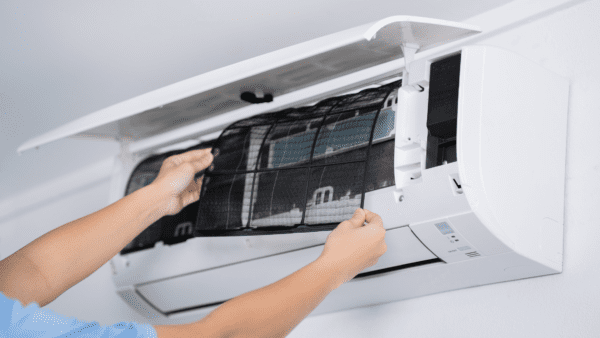The Money-Saving Benefits of Changing Your Air Filter

The heater is one of the most vital yet commonly overlooked home appliances that could be sucking money right out of your pocket. Furnace filters clogged with dust and debris restrict airflow and can strain your heating system. The typical American household spends around one thousand dollars on heating bills every year.[1] This number easily increases when your system is left working overtime. Replacing a dirty, congested air filter allows air to flow freely again—saving you money on your utility bills.
The Hidden Costs of Neglected Furnace Filters
It’s easy to overlook a small air filter while more obvious home maintenance is top of mind. However, dismissing proper furnace care comes with sneaky long-term expenses. The incremental extra electricity usage and subtle system strain add up.
Higher Energy Bills
Letting dust and debris clog your air filter restricts airflow through the HVAC system. To compensate, your furnace works extra hard, pushing enough air through the congested filter to maintain the set temperature. This unnecessary energy expenditure shows up in higher electricity costs. By replacing a dirty filter, your furnace can breathe freely again and can cut your energy bills by 5-15%.[2]
Premature Breakdowns & Shortened Equipment Lifespan
Running a furnace at max effort around the clock also puts more wear and tear on internal components. This strains the system, leading to faster parts breakdowns that should operate smoothly for 10-15 years in optimal conditions.[3] Skipping regular furnace filter changes can degrade indoor air quality while cutting your HVAC lifespan in half, leaving you to face pricey repairs or system replacements years sooner than expected.
The costs of ignoring clogged furnace filters add up over time. Implementing seasonal filter changes keeps your system running efficiently for years to come.
Top 5 Benefits of Changing Furnace Filters
Replacing your furnace air filters delivers major dividends for a small time investment. Here are the top benefits of seasonal filter maintenance.
- Allows Air to Flow Freely: A clean, debris-free filter offers minimal air resistance. This allows your blower to easily maintain proper airflow through the ducts and vents heating/cooling your home. Less strain on your HVAC equals lower electricity usage and costs.
- Improves System Efficiency: When air moves freely through an unclogged filter, every component in a furnace functions more efficiently. Heat exchangers, blowers, compressors, and fans don’t have to work overtime to compensate for restricted airflow.
- Traps More Dust & Allergens: A clean filter catches more dust, pollen, pet dander, and smoke particles. Keeping these irritants and carcinogens out of indoor air protects your furnace while improving home air quality.
- Prevents Buildup & Clogs: Changing filters regularly prevents debris accumulation from escalating into tightly packed clumps and clogs inside your ductwork and HVAC components. This buildup strains systems over time.
- Extends Equipment Lifespan: Routine filter changes every 90 days or as needed to keep your entire HVAC system operating smoothly for a decade or longer. Remember – prevented breakdowns equals more money saved!
The few minutes per season needed to monitor and replace furnace filters translates to years of optimized performance and energy savings from your heating and cooling equipment.
DIY Guide to Changing Furnace Filters
Replacing a furnace air filter when it becomes congested with dust doesn’t require calling in an HVAC technician. With a few basic steps, checking and swapping clogged filters is easy seasonal maintenance you can do yourself between annual professional check-ups.
When to Replace Your Filter
- Refer to your owner’s manual for the filter replacement timeframe recommended for your system (typically 3-6 months).[4]
- Check filters monthly during peak heating/cooling season when your furnace runs most.
- Replace earlier if the filter appears visibly dirty or airflow seems restricted.
Signs Your Filter Needs Replacing
- Reduced airflow from vents indicating clogged filter
- Dust accumulation is visible around vents as air leaks out
- Unusual furnace sounds like rattling or loud operation
- Fuse blowing or system overheating forcing shutdown
How to Change the Filter
- Turn off your furnace
- Locate the filter access panel on the furnace front or side
- Remove the old clogged filter and discard
- Check arrows on the new filter point in the airflow direction
- Securely slide the replacement filter inside
- Close furnace access panel
For additional savings, reusable filters are also available, though they tend to be less efficient at catching smaller particles.[5] If you have a reusable filter, clean it by lightly scrubbing it with warm water and gentle household soap.
Additional Perks: Better Indoor Air Quality
On top of the cost savings, keeping your furnace filter clean through timely replacements also boosts home air quality. This delivers a cleaner, healthier indoor atmosphere and reduces energy and repair costs.
Traps Allergens & Reduces Congestion
High-efficiency pleated filters are engineered to capture microscopic allergens like pollen, mold spores, pet dander, and dust mites circulating through your home. Removing these particles from the air minimizes allergy and asthma triggers.
Captures Odors & Chemicals
Furnace filters trap home air pollutants like by-products from cleaning sprays, smoke residues, scented candles, smells from pets, foods, and more before they spread through your home.
Prevents Settling Dust Buildup
Pleated filters catch tons of micro-particles like dust and dander that would otherwise be pushed out your vents to slowly accumulate as grime on your walls, furniture, and floors. Cleaner indoor air means less frequent dusting!
By handling easy seasonal furnace maintenance, you ensure a steady supply of cleaner, healthier air for your household while saving on bills. For optimal savings and comfort, don’t overlook air filter care!
Schedule Seasonal HVAC Check-Ups
To maximize savings, have an HVAC technician conduct tune-ups and cleaning annually before peak summer and winter seasons.
Annual Furnace Inspections Include:
- Checking refrigerant levels
- Lubricating moving parts
- Inspecting belts and hoses
- Cleaning coils and condensers
- Testing for gas leaks
- Verifying proper operations
Addressing problems early maximizes performance and savings. Major part replacements or complete system swaps can get expensive, so preventing breakdowns through maintenance is an excellent way to save money throughout the year.
Schedule maintenance checks to keep your HVAC system running like new year after year. Technicians can also confirm your filter replacement schedule and recommend upgraded options to maximize airflow and energy efficiency.
Similar Posts:
- Maximizing Energy Efficiency in Your Home: Sustainable Solutions for Lower Bills
- 3 Effective HVAC Cleaning and Maintenance Tips
- 5 Most Common HVAC Airflow Problems & How to Fix Them
- Simple Heater Repair You Can Try Before Calling A Professional
- Lower Your Expenses With 3 Simple Maintenance Steps for Your Air Conditioner









